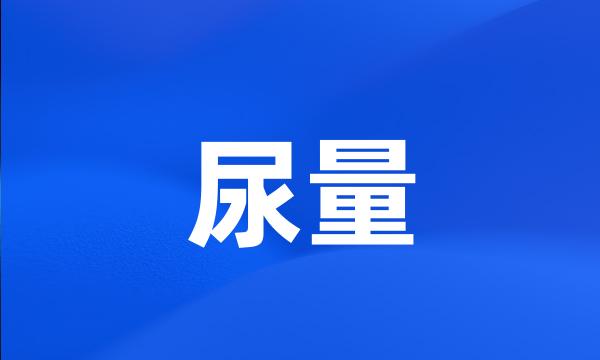尿量
- 网络urine volume;urine output;Urine;Urinary output
 尿量
尿量-
两组尿量及SCr、BUN无明显变化。
There were not any significant differences of urine volume , SCr and BUN between two groups .
-
结果:低张胶体液可显著改善MAP及CO,增加尿量,降低血浆渗透压,预防脑、肺水肿的发生。
Results : hypotonic liquid containing colloid could effectively ameliorate MAP and CO , improve urine volume , decrease plasma osmotic pressure and prevent occurrence of lung and brain edema .
-
B组的尿量较A组多(P0.05)。
Urine output in group A is significant less than in group B ( P0.05 ) .
-
结果:①A组昼夜尿量与B、C组比较,差异有显著性意义(P<0.05)。
Results : ① There were significant difference ( P < 0.05 ) in the day-night voided volume between group A and group B or C.
-
监测每小时尿量、比重和pH值在抢救大面积烧伤休克中的地位
The significance of monitoring per-hour output , specific gravity and pH value of urine in emergency treatment of extensive burn shock
-
R组尿量和总输液量明显高于H组(P<0.05)。
Urine volume and the total solution volume in R group were obviously higher than those in H group ( P < 0.05 ) .
-
用药4周后,收集24h的总尿量。
After 4 weeks , total volume of urine were collected for 24 h.
-
根据患儿体重分类和烧伤面积计算24h液体需要量,输液泵均匀控制输液速度并根据每小时尿量进行调整。
The infusion rate was adjusted with a pump infusion according to urine output per hour .
-
结果表明:PSS与阿莫地平均可明显促进肾血流,使尿量增加(P<0.01)。
Both PSS and amlodipine significantly increased renal blood flow and urine flow ( P < 0.01 ) .
-
尿量增加,尿毒症的症状消失,BUN、Cr恢复正常。
The urine volume of them were increased , symptoms of urinemia were disappeared , BUN and creatinine were normal after operations .
-
结果表明:PSS与Aml均可促进大鼠和狗肾血流,使尿量增加(P0.01)。
The results showed that both PSS and Aml significantly increased renal blood flow and urine flow ( P0.01 ) .
-
常规监测心电图、血压及尿量,C组还监测中心静脉压(CVP)及桡动脉压。
ECG , blood pressure and urine volume were checked as a routine , group C were monitored the CVP and radial artery pressure .
-
目的:探讨前列腺增生症(BPH)所致膀胱出口梗阻(BOO)类型对膀胱排空及剩余尿量的影响。
Purpose : To investigate the effect of obstructive type on residual urine volume in BPH .
-
失血量(1046±347)ml,术中CVP及尿量均维持在正常范围。
Blood loss was ( 1 046 ± 347 ) ml , and VCP and urine were maintained within normal limits .
-
结果:B组治疗后尿量显著增加;两组心肌酶谱、肾功能各项指标均显著升高,但B组显著低于A组。
Results : Group B 's urine increase after being treated , indications like heart muscle enzyme , kidney functions of the 2 groups clearly rise a lot , but group B is lower than group A.
-
结果发现:经过2个月治疗,两组病例平均尿量都有显著减少(P均<0.01),尤以温阳化气组减少为著(P<0.05);
Results showed that after 2 months treatment , the urine volumes in both groups were all markedly decreased ( P < 0 . 01 ) . especially the former group ( P < 0 . 05 ) .
-
术中加强血流动力学、尿量、体温等监测,术中各时期及术后24h测定血浆尿素氮(Bun)、血肌酐(Cr)水平。
The contents of serum creatinine ( Cr ) and blood urea nitrogen ( Bun ) were tested during each phase of operation and 24 h postoperative .
-
观察治疗1个月前后24h尿量、24h尿蛋白定量、血肌酐、血尿素和血浆白蛋白的变化。
24 h urine excretion , 24 h urine protein quantity , plasm albumin , Scr and BUN were observed before and 1 month after therapy .
-
S组出汗量比F组高14%,尿量少21%,尿蛋白转阳性率较低,血红蛋白增高和血容量减少较小。
As comparing group S with group F , the sweat amount was larger , urine volume and the percentage of proteinuria were lesser , the increase of Hb and decrease of blood volume were lighter .
-
记录ICU期间观察指标,包括机械通气时间、ICU停留时间、血管活性药物使用时间、患者的液体出入量、尿量。
Recorded relevant datas of ICU period : the duration of mechanical ventilation and ICU stay , usage of vasoactive agent , fluid intake and output , urine volume .
-
尿量成人保持在100ml/h以上,小儿在30ml/h以上,红细胞压积在50%以下。
For adults , urine output was kept above 100 ml / hour and for children 30 ml / hour . Hematocrit was kept below 50 % .
-
AKI的诊断标准应以血清肌酐或者尿量的急性改变为基础。
Diagnostic criteria for AKI are proposed based on acute alterations in serum creatinine or urine output .
-
结果:术后患者血清尿素氮(BUN)、肌酐(Cr)恢复正常或接近正常,尿量恢复,结石排净率88%(22/25)。
Results : All patients serum BUN and Cr levels decreased in different degree or return to normal , stone-free rates were up to 88 % ( 22 / 25 ) .
-
异丙酚输注后伴随的循环抑制导致尿量减少,肌苷滤过率降低,但肾功能没明显改变,β2微球蛋白无明显变化,肾组织ET减少,CGRP增加;
Creatinine clearance rate decreased significantly but without the alternation of renal function and changes of β 2-MG . The concentration of ET in renal tissue decreased significantly and CGRP increased significantly .
-
方法随机选择66例开始进行维持性血液透析治疗的患者,记录24h残存尿量,同时使用改良定量整体主观评估法(MQSGA)评估患者营养状况;
Methods Residual urine volumes in 24 hours of 66 hemodialysis patients were registered and the nutritional status were assessed with Modified Quantitative Subjective Global Assessment before beginning dialysis .
-
观察无肝期输液量、血液动力学和尿量,检测血清肌酐(Cr)和肌酐清除率(CCr)。
Venous blood samples were taken and urine was collected during anhepatic phase for determination of serum creatinine ( Cr ) concentration and creatinine clearance ratio ( CCr ) was calculated .
-
患者的IPSS与血清PSA水平具有一定的正相关性。患者的PSA与残余尿量和最大尿流率均无明显相关性。
IPSS is possiblely correlated with PSA , while there is no obvious correlation between serum PSA and residual urine or maximum urine rate of flow .
-
血压、心率、尿量及主要症状、体征的复常时间治疗组均明显短于对照组(P均<0.01)。
The resuming time of blood pressure , heart rate , urinary volume and the vanishing time of main symptoms and signs in the treated group were significantly shorter than those in the control group , and the difference was significant ( all P < 0 01 ) .
-
结果采用参附注射液静点组测定治疗后KT/V值,Ccr,RRF及尿量等均优于对照组。
Results The KT / V , CCR , RRF and urine volume in therapy group were better that those in control group .
-
结果:与治疗前比较,阿佐塞米组治疗后24h尿量明显增加,伴随体质量显著下降[(3.3±3.6)kg],与呋塞米组相似;
Results : After treatment , 24 h urine volume in azosemide group increased markedly and body weight decreased by ( 3.3 ± 3.6 ) kg , the same was true to furosemide group .
